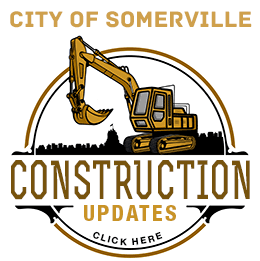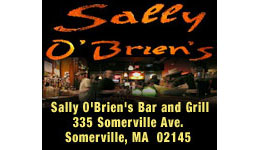
The planning board recently voted in favor of major zoning changes around Porter Square, including allowing commercial activity on stretches of Elm Street that today are entirely residential. – Photo by Elizabeth Sheeran
Recommended changes will impact residential areas
By Elizabeth Sheeran
Somerville planners last week moved a step closer to declaring the city’s Porter Square area open for business. At least, more open than it has been until now.
The majority of the Planning Board voted on February 2 to recommend a comprehensive re-zoning plan for the area from Wilson Square, where Somerville Avenue meets Elm Street, to the Cambridge-Somerville line at Porter Square.
The proposal, which now goes to the Board of Alderman, retains residential zoning in the interior core of the triangle formed by Somerville Avenue, Elm Street and White Street, facing the Porter Square shopping center. But it expands the types of commercial activity that will be permitted along those three arteries, and that includes allowing for new businesses along stretches of Somerville roadways that today are entirely residential.
City officials say Somerville can’t get its fair share of the economic opportunity presented by Porter Square without making major changes to the zoning map. “Although the area represents one of the busiest pedestrian and bicycle areas in Somerville, economic activity is largely captured by Cambridge,” wrote Mayor Joseph Curtatone, in a November letter to the Board of Alderman, in support of the rezoning plan.
The Mayor pointed to economic data that shows $340 million in consumer spending within a half-mile radius of Porter Square, while new construction on the Somerville side of the city line has been stagnant since 1995. And city planners report that property values are 40 percent higher in Cambridge.
“Presently, the largest challenge for economic development – necessary to relieve the tax burden from residential owners – is caused by the existing restrictive zoning regulations,” wrote Mayor Curtatone.
The recommended zoning changes, which are the product of a public process that began in 2009, will introduce Corridor Commercial District zoning along most of Somerville Avenue and around White Street and Wilson Square, permitting businesses in the range of 45-55 feet high (four to five stories).
The plan will also create a Transit Oriented District for the air rights over the MBTA line along Somerville Avenue, in the hopes of encouraging commercial business development over the recessed tracks, in the same way that there is a Shaw’s grocery store built out over the Massachusetts Turnpike in Newton.
Planning Director George Proakis said that part of the plan, which permits buildings up to around six stories, could turn an eyesore into a commercial tax engine. “If you’re walking down Somerville Avenue today toward Beacon Street, you’re only one block out of Porter Square, and what you’ve got is a chain link fence and a sidewalk, and you’re looking down into a hole in the ground,” said Proakis.
But Proakis said the aspect of the plan that has generated the most public debate is not what is proposed for Somerville Avenue, nor along White Street or around Wilson Square. The most controversial part of the proposal involves the rezoning of the southwestern side of Elm Street, which is currently classified as RB, a residential-only district consisting of mostly two and three-story homes, with some multi-family units.
The rezoning would expand the RC classification that already exists on the northeast side of Elm Street to include both sides of the street. It would effectively allow ground-floor commercial activity on the southwest side of the street, where it does not exist today.
“I don’t imagine that would change the nature of the structures that much, but it would allow some law offices and similar businesses to go in there, and that seems to have been the thing that has generated the most conversation at this point,” said Proakis.
At last Thursday’s planning board meeting, board member Michael Capuano said he supported an alternative plan, a so-called “Option Two,” which would retain the RB residential zone along the southwest side of Elm Street, because residents in the neighborhood were opposed to the change.
“I just don’t think it’s the right message to send to the neighborhood to tell people who don’t want it, ‘I’m sorry, but our plans for the area going forward are more important than the homes there,’ ” said Capuano. “Why am I going to make people who hate the idea of having their homes downzoned make the same arguments again in front of the Board of Aldermen?”
Planning Board Chairman Kevin Prior said the rezoning plan recommended by the city planning staff was the end result of an “open, public process,” and moved the vote to recommend the plan to the Board of Aldermen.
“We have to open the door. We have to allow these possibilities,” said Prior, saying a worst-case scenario for overdevelopment in the neighborhood was unlikely. “For everyone who spoke against it, they or their families would have to turn over their parcels of land to someone who was looking to accumulate all kinds of parcels of land in that area to develop it seriously. We need to stop closing our minds to the possibilities of development in this city.”
A majority of the planning board voted to recommend the rezoning ordinance as written and to send it to the Board of Alderman, with Capuano voting against it.
Board member Elizabeth Moroney said she would have preferred to have had the opportunity to vote on Option Two, because it did “what we wanted it to do and protects what we wanted to protect.” But she ultimately voted in favor of the rezoning recommendation. “I think it’s important that the city gets ahead of the economy,” said Moroney.
Residents were not invited to speak at the meeting, since the public comments period had closed. But more than a dozen were in attendance. Almost immediately following the vote, unhappy neighbors were already exchanging contact information and discussing possible next steps in opposing the rezoning plan.
“I don’t like to see them come in and destroy my neighborhood,” said Mary Ghioni, a Mossland Avenue resident who has lived in the neighborhood for 50 years, and owns six properties there. “They think they know what’s best for the neighborhood. I take pride in my neighborhood and what they’re trying to do is destroy it.”













Reader Comments